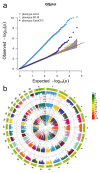The Genetic Characteristics of FT-MIRS-Predicted Milk Fatty Acids in Chinese Holstein Cows
- PMID: 39409850
- PMCID: PMC11476120
- DOI: 10.3390/ani14192901
The Genetic Characteristics of FT-MIRS-Predicted Milk Fatty Acids in Chinese Holstein Cows
Abstract
Fourier Transform Mid-Infrared Spectroscopy (FT-MIRS) can be used for quantitative detection of milk components. Here, milk samples of 458 Chinese Holstein cows from 11 provinces in China were collected and we established a total of 22 quantitative prediction models in milk fatty acids by FT-MIRS. The coefficient of determination of the validation set ranged from 0.59 (C18:0) to 0.76 (C4:0). The models were adopted to predict the milk fatty acids from 2138 cows and a new high-throughput computing software HiBLUP was employed to construct a multi-trait model to estimate and analyze genetic parameters in dairy cows. Finally, genome-wide association analysis was performed and seven novel SNPs significantly associated with fatty acid content were selected, investigated, and verified with the FarmCPU method, which stands for "Fixed and random model Circulating Probability Unification". The findings of this study lay a foundation and offer technical support for the study of fatty acid trait breeding and the screening and grouping of characteristic dairy cows in China with rich, high-quality fatty acids. It is hoped that in the future, the method established in this study will be able to screen milk sources rich in high-quality fatty acids.
Keywords: Fourier Transform Mid-Infrared Spectroscopy (FT-MIRS); fatty acid content; genetic characteristics; genome-wide association study; milk.
Conflict of interest statement
The authors declare no conflicts of interest.
Figures



Similar articles
-
Comparison of the genetic characteristics of directly measured and Fourier-transform mid-infrared-predicted bovine milk fatty acids and proteins.J Dairy Sci. 2022 Nov;105(12):9763-9791. doi: 10.3168/jds.2022-22089. Epub 2022 Oct 26. J Dairy Sci. 2022. PMID: 36307235
-
The Characteristics of Milk Fatty Acid Profile Predicted by Fourier-Transform Mid-Infrared Spectroscopy (FT-MIRS) in Chinese Holstein Cows.Animals (Basel). 2024 Sep 26;14(19):2785. doi: 10.3390/ani14192785. Animals (Basel). 2024. PMID: 39409734 Free PMC article.
-
Predictions of Milk Fatty Acid Contents by Mid-Infrared Spectroscopy in Chinese Holstein Cows.Molecules. 2023 Jan 9;28(2):666. doi: 10.3390/molecules28020666. Molecules. 2023. PMID: 36677723 Free PMC article.
-
The potential of Fourier transform infrared spectroscopy of milk samples to predict energy intake and efficiency in dairy cows.J Dairy Sci. 2016 May;99(5):4056-4070. doi: 10.3168/jds.2015-10051. J Dairy Sci. 2016. PMID: 26947296 Review.
-
The evolving role of Fourier-transform mid-infrared spectroscopy in genetic improvement of dairy cattle.J Anim Sci Biotechnol. 2020 Apr 17;11:39. doi: 10.1186/s40104-020-00445-2. eCollection 2020. J Anim Sci Biotechnol. 2020. PMID: 32322393 Free PMC article. Review.
References
-
- Fleming A., Schenkel F.S., Chen J., Malchiodi F., Bonfatti V., Ali R.A., Mallard B., Corredig M., Miglior F. Prediction of milk fatty acid content with mid-infrared spectroscopy in Canadian dairy cattle using differently distributed model development sets. J. Dairy Sci. 2017;100:5073–5081. doi: 10.3168/jds.2016-12102. - DOI - PubMed
-
- Bhavadharini B., Dehghan M., Mente A., Rangarajan S., Sheridan P., Mohan V., Iqbal R., Gupta R., Lear S., Wentzel-Viljoen E., et al. Association of dairy consumption with metabolic syndrome, hypertension and diabetes in 147 812 individuals from 21 countries. BMJ Open Diabetes Res. Care. 2020;8:e000826. doi: 10.1136/bmjdrc-2019-000826. - DOI - PMC - PubMed
-
- Caredda M., Addis M., Ibba I., Leardi R., Scintu M.F., Piredda G., Sanna G. Prediction of fatty acid content in sheep milk by Mid-Infrared spectrometry with a selection of wavelengths by Genetic Algorithms. LWT. 2016;65:503–510. doi: 10.1016/j.lwt.2015.08.048. - DOI
Grants and funding
- 2021YFE0115500/the Inter-Governmental International Science and Technology Cooperation Project of the State Key Research and Development Program
- 2662023DKPY001/Fundamental Research Funds for the Central Universities
- none/Dairy Industry Innovation Team Genetic Resources Development and Utilization Cooperation Project of Hebei Province.
LinkOut - more resources
Full Text Sources
Miscellaneous

